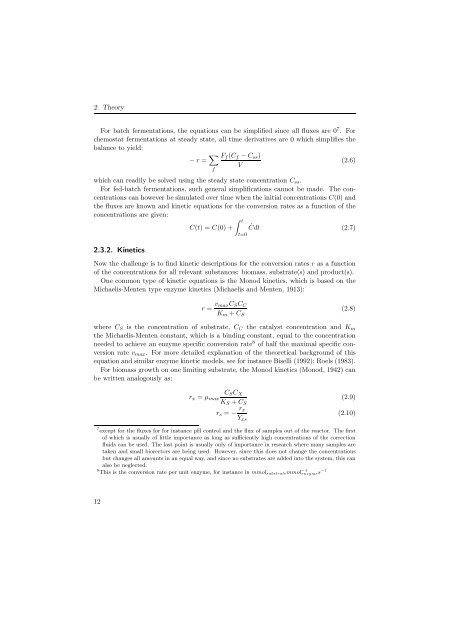Corynebacterium glutamicum - JUWEL - Forschungszentrum Jülich
Corynebacterium glutamicum - JUWEL - Forschungszentrum Jülich
Corynebacterium glutamicum - JUWEL - Forschungszentrum Jülich
Create successful ePaper yourself
Turn your PDF publications into a flip-book with our unique Google optimized e-Paper software.
2. Theory<br />
For batch fermentations, the equations can be simplified since all fluxes are 0 7 . For<br />
chemostat fermentations at steady state, all time derivatives are 0 which simplifies the<br />
balance to yield:<br />
− r = �<br />
f<br />
Ff (Cf − Css)<br />
V<br />
(2.6)<br />
which can readily be solved using the steady state concentration Css.<br />
For fed-batch fermentations, such general simplifications cannot be made. The concentrations<br />
can however be simulated over time when the initial concentrations C(0) and<br />
the fluxes are known and kinetic equations for the conversion rates as a function of the<br />
concentrations are given:<br />
2.3.2. Kinetics<br />
� t<br />
C(t) =C(0) +<br />
t=0<br />
˙Cdt (2.7)<br />
Now the challenge is to find kinetic descriptions for the conversion rates r as a function<br />
of the concentrations for all relevant substances: biomass, substrate(s) and product(s).<br />
One common type of kinetic equations is the Monod kinetics, which is based on the<br />
Michaelis-Menten type enzyme kinetics (Michaelis and Menten, 1913):<br />
r = vmaxCSCC<br />
Km + CS<br />
(2.8)<br />
where CS is the concentration of substrate, CC the catalyst concentration and Km<br />
the Michaelis-Menten constant, which is a binding constant, equal to the concentration<br />
needed to achieve an enzyme specific conversion rate 8 of half the maximal specific conversion<br />
rate vmax. For more detailed explanation of the theoretical background of this<br />
equation and similar enzyme kinetic models, see for instance Biselli (1992); Roels (1983).<br />
For biomass growth on one limiting substrate, the Monod kinetics (Monod, 1942) can<br />
be written analogously as:<br />
CSCX<br />
rx = µmax<br />
KS + CS<br />
rs = − rx<br />
Yxs<br />
(2.9)<br />
(2.10)<br />
7 except for the fluxes for for instance pH control and the flux of samples out of the reactor. The first<br />
of which is usually of little importance as long as sufficiently high concentrations of the correction<br />
fluids can be used. The last point is usually only of importance in research where many samples are<br />
taken and small biorectors are being used. However, since this does not change the concentrations<br />
but changes all amounts in an equal way, and since no substrates are added into the system, this can<br />
also be neglected.<br />
8 This is the conversion rate per unit enzyme, for instance in mmolsubstratemmol −1<br />
enzymes −1<br />
12

















